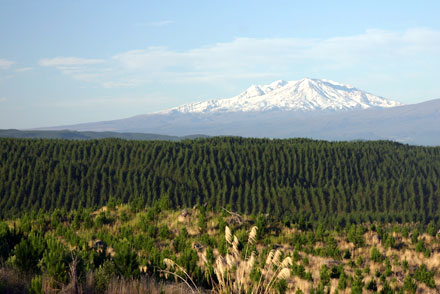
New Zealand Forest owners are saying the extent of overseas investment in forestry this year is grossly exaggerated. They say the calls on the government to restrict conversions of farms to forestry are dangerously jeopardising the fight against climate change and New Zealand’s hope of achieving its greenhouse gas emission targets. Source: Timberbiz
Forest Owners Association President Peter Weir said there is no doubt that the rate of planting forests on poorer quality farmland is increasing. But he says most of the planting is driven by higher returns from forests than by hill country farming and the planting is being done by New Zealand land owners and not overseas investors.
“Anyone can go to the Overseas Investment Office website and see the approvals for actual purchases of New Zealand farmland for planting. The total over the past year is a mere 8600 hectares. So, claims that the rules for overseas investment in farms for forest planting are ‘totally out of control’ are quite misleading.
“That 8600 hectares represents only one-thousandth of the total land in sheep and beef farming for New Zealand. It’s hardly a takeover as some of the news media are trying to pretend.
“The value of that land is a fraction of the overseas investment approved in the dairy industry over the past year. If you look at dairy company sales with Westland Dairy, New Zealand New Milk and Mataura Valley Milk, then you can see foreign investment in our dairy industry in 2019 is nearly four times greater than the forestry total, but without exciting anywhere near the same media obsession.”
Mr Weir said that without overseas investment in forestry over the past few years there would hardly be a forest industry worth talking about.
“It was mostly investors from overseas who were prepared to wait a number of years for their investment to mature and see the trees harvested,” he said.
“But that appears to have changed recently. Farmers are getting out of the price doldrums of wool growing and the modest returns for meat. For some farmers the economics of sheep and beef production clearly does not add up over the long term.”
Mr Weir said carbon credits also play a part in farmer decisions. The carbon credits are currently a modest NZ$25 dollars a tonne. But farmers are apprehensive about the costs of complying with freshwater reform and the adjustment which will be necessary to reduce farm greenhouse gas emissions under the terms which have recently been agreed to with the government.
“New Zealand has tough greenhouse gas emission targets, and to meet them, large areas of farmland will have to be planted in trees to sequester carbon from the atmosphere,” Mr Weir said.
“If the government gets spooked into restricting planting trees because of some ill-informed views on the extent of overseas investment, and some equally illusory notions that forestry employs fewer workers, then it would be a step backwards and dangerously jeopardise our ability as a nation to meet emissions targets.”
Farm Forestry Association President Hamish Levack said demands on the government to restrict forest planting is a direct attack on farmers themselves.
“Small scale foresters, which usually means farmers with woodlots, are responsible for logging 40 percent of the current harvest,” he said.
“I can’t see how Federated Farmers groups are calling for restricting the rights of many of their own members to plant out their properties, or to sell their farmland to whoever they like to plant forests on part or all of the farm.”
He was critical of the news media assumption that an expansion of forestry will automatically reduce the workforce.
“The Statistics Department figures comparing workers on farms with workers in forests show there are more forest workers per each thousand hectares. Indeed, it’s true that the forest workforce is concentrated at harvest, but that makes no difference at all to the year-in-year-out average,” Mr Levack said.





